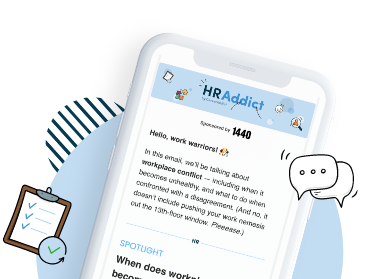Human resource management has undergone significant evolution in recent years. What was once a department primarily responsible for recruitment and payroll is now a strategic partner in major business operations. HR’s growing involvement in key business decisions is the reason why a growing number of organizations are now utilizing HR software and analytics.
In this blog, we’ll explore how HR software can enable data-driven decision-making within businesses and bring leaders and teams closer to achieving organizational goals.
TABLE OF CONTENTS
- The shift toward data-driven HR management
- Why traditional HR practices fall short
- How HR software programs enable smarter decision making
- The role of automation in reducing human errors
- Improving strategic workforce planning
- Integrating HR insights with broader business objectives
- Overcoming challenges
- FAQs
The shift toward data-driven HR management
Traditionally, HR was a small organizational department that handles recruitment and paychecks. However, as industries grew and operations became more complex and strategic, organizations realized that employee retention, job satisfaction, and productivity are key factors to achieve success. This is how HR evolved to become a strategic partner in business operations.
As HR management now moves beyond basic strategies, it incorporates high-tech software that runs on key employee and organizational data. HR professionals analyze this data, along with a combination of tools and technologies, to make informed decisions that enhance employee engagement, retention, and other workplace metrics. This ultimately helps boost employee morale and confidence, enabling organizations to align faster with their goals.
Why traditional HR practices fall short in modern workplaces
Modern workplaces face complex problems that traditional HR practices cannot adequately address. Here’s why:
Reliance on manual processes and spreadsheets
Traditional HR practices involve using manual processes, such as building and maintaining spreadsheets to manage employee data. Since these processes are manual, they can be time-consuming and are prone to human error.
Limited access to real-time employee data
In traditional HR practices, employee data aren’t recorded automatically. They have to be entered into the system manually, which means there can be delays in data collection. As a result, an organization’s access to real-time employee data is also limited.
Inconsistent performance tracking and reporting
Manual reporting lacks algorithms and typically doesn’t include dashboards. There are also no preset metrics to track employee performance. These old methods are prone to inconsistencies and inaccuracies, and do not reflect real-time employee performance.
Lack of predictive insights for workforce planning
Predictive analytics and insights were introduced in the world of HR after organizations started deploying automation tools and AI-powered HR software. Traditional HR practices lack the ability to provide predictive insights, which are key factors in modern workforce planning.
Difficulty measuring HR’s impact on business outcomes
In traditional HR departments, they're either not aligned with organizational goals or find it hard to do so, mostly because their primary focus is on recruitment, compensation, and employee management. But this lack of strategic alignment between HR and organizational objectives makes it difficult to measure HR’s impact on business outcomes.
Inability to scale with a growing workforce
Manual tracking and reporting can only get so far without becoming strenuous. As workforces grows, traditional HR practices often struggle to remain consistent and reliable, whereas automated systems are designed to be scalable with a growing workforce.
How HR software programs enable smarter decision-making
HR software is an automated system that brings efficiency to core HR functions and empowers smarter decision-making in the following ways:
Centralized data collection and accessibility
HR software can store employee data, including their personal information, compensation details, performance trends, and more, in one centralized location. This organized and streamlined data storage, all in one place, allows more control and better accessibility.
Real-time analytics and reporting
A good HR software does not only store data. It also comes with dashboards, where HR can track trends, analyze insights, and build reports based on the real-time performance of each employee. HR professionals can access the information they need at any time.
Workforce planning and predictive insights
Since HR software provides automated data collection and analytics, it can be used to identify employee retention trends and provide valuable insights about the workforce. Organizations can leverage these insights to make key decisions about workforce planning.
Performance tracking and employee engagement metrics
Advanced HR software programs also enable HR to automate performance analysis. If the output isn’t ideal, details from the analysis can be easily used to create personalized employee training plans. This saves time significantly compared to manually reviewing performance records to look for trends and potential issues.
The role of automation in reducing human errors
When the entire HR department is run manually using traditional methods, there’s always a risk of inaccuracies, errors, and missing information, which can hinder effective workforce planning. Automated HR systems employ sophisticated algorithms that use data analytics when making recommendations. Using this for core HR functions and key business processes is an efficient way to reduce issues commonly encountered in outdated methods. It can also help facilitate strategic partnerships between leadership and employees.
How HR software improves strategic workforce planning
In the modern workforce, where automation is taking over, HR software is key to enhancing strategic workforce planning. Its advanced data analysis capabilities not only saves time, but also provide leaders with detailed information and even predictions and forecasts that can facilitate wiser business decisions.
Identifying skill gaps and training needs
HR software can assess employees' skill sets and experience profiles in comparison to their performance and organizational needs. It identifies skill gaps and recommends strategies that HR professionals can implement to train and develop employees.
Enhancing talent acquisition and retention strategies
HR software can automate several time-consuming talent acquisition processes, including résumé screening, shortlisting, candidate scoring, email distribution, and scheduling interviews. It also helps with planning employee engagement and training strategies, which are key to productivity and retention.
Integrating HR insights with broader business objectives
A key benefit of using HR software is the insights it provides about employee performance and potential skill gaps. HR professionals can review and analyze these insights to gain a deeper understanding of underlying issues and what it would take to achieve the company’s goals.
These insights also help align HR functions, such as talent acquisition, performance management, and training, all to support broader business objectives. All-in-one HR systems, such as Paycom’s HR software, provides valuable insights to help create a bridge between employees and company-wide KPIs.
Overcoming challenges in data-driven HR implementation
Shifting to automated HR systems from years of traditional practice is not easy. There are several challenges you need to overcome to establish a solid HR foundation.
Breaking down data silos across HR systems
Data only works if it’s shared and accessible to the right people. The integration of data across various HR systems, within a proper corporate framework, ensures transparency throughout the workplace and enables the workforce to improve compliance and make informed decisions.
Ensuring data accuracy and consistency
HR systems only work reliably if the data you feed into the systems are reliable and accurate. Many organizations fail to adapt these systems because they lack a consistent method for collecting and storing data.
Addressing privacy and compliance concerns
Although transparency is crucial when implementing HR systems, concerns about privacy, confidentiality, and compliance cannot be ignored. Organizations must implement strict policies and technical safeguards to protect sensitive data from unauthorized access and disclosure.
Building analytical skills within the HR team
Relying on HR systems requires the ability to understand and analyze the data these systems provide. A good HR software will provide data that’s easy for anyone to understand. However, to be truly competitive, data cleaning and analytical skills are a must to further decode the output and align it with organizational strategies.
Integrating legacy systems with modern HR platforms
Now is the time for companies relying on legacy HR systems to transition to modern platforms, so they can adapt to the growing needs of their workforce. However, no one wants to lose the data of their systems in the transition. This is why it’s important to integrate legacy systems with compatible modern tools.
Maintaining data security in cloud-based HR software
A common misconception in organizations is that data is safer when it’s recorded manually and stored on physical devices, as opposed to automated cloud-based HR software. The truth is, if you take the right steps, most cloud-based software are highly secure, especially when implemented with robust authentication protocols.
Final thoughts: Building a culture of data-backed HR decisions
Adopting HR software is not just an option in today’s workforce demands; it’s a necessity if you want to scale, access real-time data, and make smarter decisions about your business. However, switching from traditional practices to modern platforms presents its fair share of challenges, including security risks, integration compatibility, and privacy concerns. An efficiently implemented HR software can significantly reduce these risks and help you overcome transitional challenges more smoothly.
FAQs
How does HR software help improve decision-making?
HR software stores and analyzes key employee data to generate reports and provide insights that HR professionals can use to guide business decisions. Since these reports are automated with higher accuracy, the decisions made with them are more likely to yield better outcomes than if they were made with manual processes and estimation.
What types of HR data are most valuable for analytics?
Generally, the most valuable HR data for analytics includes metrics and KPIs related to recruitment efficiency, such as cost-to-hire and time-to-hire, as well as employee engagement and retention, including turnover rate, absenteeism, and employee satisfaction scores. However, these metrics should be adjusted depending on workplace culture and needs.
Can HR software predict employee turnover or performance issues?
Yes, HR software can predict employee turnover by analyzing the organization's historical data. With the correct employee data, it can also identify skill gaps and performance issues, which HR professionals can use to develop personalized training programs.
How does HR analytics support business growth?
HR analytics support business growth by enabling faster, smarter, and data-driven decision-making. This efficient decision-making improves work performance, reduces costs, and helps align HR with business goals.
How does third-party HR software enhance data-driven HR strategy?
Third-party HR platforms/software offer centralized data collection and analysis, as well as advanced automation and evidence-based insights. These key features enable HR professionals to develop strategies that can enhance productivity across the entire workforce.
What challenges do companies face when implementing HR software?
Some common challenges that companies face when implementing HR software include ensuring data accuracy and consistency, addressing privacy concerns, adhering to compliance standards, overcoming resistance to technology adoption, building analytics capabilities, integrating legacy systems with a modern tool, and eliminating security risks.
What are some future trends in HR data analytics?
Future trends in HR data analytics include the expanded and mainstream use of artificial intelligence (AI) across HR software. We may also see a significant rise in predictive workforce analysis, employee experience analytics, and DEI (diversity, equality, inclusion) analytics in HR systems.

